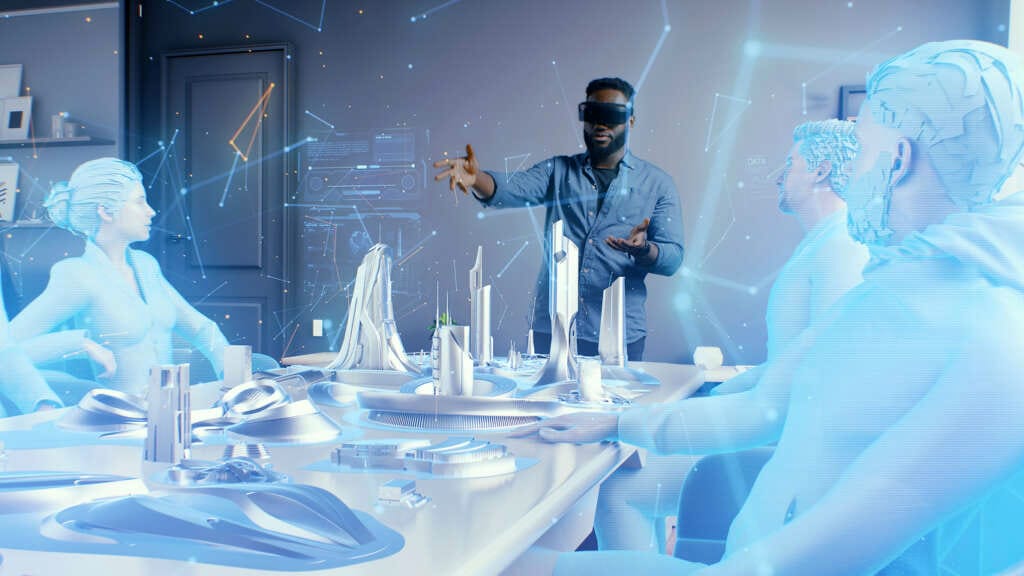

Sam Hoey

Sebastian Buks
By Sam Hoey, Lead Designer at Designit London and Sebastian Buks, Design Director at Designit Oslo
In recent years, what was once seen as a novelty entertainment medium has now become much more mainstream. Thanks in large part to our newfound adoption of remote and hybrid working, Augmented Reality (AR) has been embraced in more domains, and at a quicker rate than anticipated. From smartphone gaming to skills training and advancing medical tech, there have been several notable developments in and around AR in recent years.
As experienced designers, we’re well versed in the ways that AR can be implemented in innovative ways for a company, whether that be organisations that work in an office, a classroom, or a factory, but one opportunity we’re seeing consistently across a number of different environments is how AR can help to build a culture of innovation and connectedness in these workspaces.
The application of AR in the workplace holds great possibilities but, as is the case with most technological advancements, it has been met with notable apprehension. Probably the most common area for concern with eXtended Reality (XR) in the workplace environment is around social disconnect.
The worry is that remote working and virtual meetings can make it harder to build community and retain engagement. Among the common concerns cited by employers, missing out on visual cues; a diminished sense of team cohesion; less participation; unclear roles; and a blurred separation of work and home life are just a few. Recent research carried out by Gallup found that workers themselves also cited disconnect from organisational culture as the most significant challenge posed by a hybrid working style.
With roughly three-quarters of employers now offering some form of hybrid working arrangement, businesses have had to look for ways to enhance their employee experience through technology across a variety of different working environments.
Since the start of the pandemic, consumer AR and VR arguably saw the most notable boost, whereas large-scale adoption in business still remains largely experimental. That is not to say that it isn’t being utilised by businesses, but often any business ‘hype’ around the ability to run AR and VR effectively can be somewhat diminished by the everyday reality of facilitating its integration (whether this is costs or general practicality for its implementation).
However, the opportunities it creates are considerable. The pre-covid use of AR technology in workplaces mostly centred around singular experiences tailored for a specific task. This included using wearables and digital displays to superimpose virtual information on the physical environment for aviation, military, and industrial purposes, or developing AR platforms for marketers and creatives to launch campaigns. As such, over the years, AR has enabled these new opportunities to enhance the working processes of those businesses that have started to develop and trial it.
For example, in a previous project with Volvo Cars, we created a collaborative tool that allowed Health & Safety Engineers to validate how the car should be built using Hololens. Traditionally this process has been done with 1:1 clay models, which take weeks to manufacture. But in this project, we were able to transform a computer-aided design (CAD) to AR within hours and then carry out the same assessments using the Hololens. This is just one instance of the incredible opportunities that exist for the integration of AR technology into the workplace.
As more businesses consider how AR will become part of their workplace, the focus is moving beyond just these previous methods of use to include customer experience and an extended remote/hybrid workplace, for a more versatile space to share and collaborate amongst teams. Whilst the pandemic may have accelerated the uptick in the adoption of eXtended Reality (XR), as businesses tried to engage a more remote workforce, the emergence from the pandemic has seen this uptick somewhat plateau. Instead, XR use remains largely experimental in traditional business settings but with advancements being made all the time, there are many exciting developments set to come in the AR/VR space.
The metaverse and the workplace
Because immersive technologies can open the door to the metaverse, there is huge potential for creating a virtual workplace that can acknowledge and attend to the diverse and spontaneous character of each user.
There are a number of ways that the metaverse can be applied in a variety of workplace environments. AR could play out most saliently in skills training practices, which are utilising 3D spaces to demonstrate concepts and practise new tasks virtually, in a controlled environment. This is beneficial to businesses considering that research has shown that humans remember 10% of the material they read, 20% of the information they hear, but a staggering 90% of what they do or experience.
Beyond skills building, there is also the advancement of digital twin technology. In a workforce, digital twins (meaning a virtual representation of a real-world object or system) can mean multiple people can access expert advice and instruction while carrying out tasks in industrial, agricultural or fieldwork scenarios.
Similarly, XR could also increase health and safety for those who would have previously had to work in hazardous or hard-to-reach environments by combining their activities with on-the-ground IoT sensors and robotics that allow them to carry out tasks remotely from the safety of their location.
Despite these opportunities, there are still a number of limitations in place due to technological latency and digital inequality. Metaverse technology is still very much in its infancy, as is the integration of immersive technologies, so how well AR works in the workplace and in what contexts is still to be determined.
What we do know is that a successful virtual workplace ultimately has to balance the human experience with the experiences driven by the technology itself. Striking this balance will be important for the continued adoption, integration, and internal buy-in of AR technology across differing industries.
Likewise, digital equality will be an important facet of the continued evolution of AR and metaverse technology. As development is happening at varying rates across different sectors, there is the risk of increasing the already existing digital inequality. Limitations from varied levels of network speed, bandwidth, latency and local or cloud-computing availability only exacerbate this.
As the technology develops it’s likely that we will see the metaverse taking on multiple shapes and forms. What this will mean for the workplaces in one location, could look very different from that in another.


